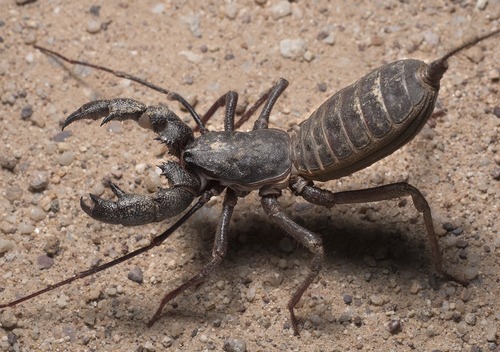Uropygi: Difference between revisions
Jump to navigation
Jump to search
mNo edit summary |
mNo edit summary |
||
| Line 28: | Line 28: | ||
|style="min-width:6em; |Uropygi | |style="min-width:6em; |Uropygi | ||
|} | |} | ||
The arachnid order Uropygi contains [[organisms]] more commonly known as whip scorpions or vinegaroons. Although they may be referred to as 'whip scorpions', they are not actually true [[scorpions]] (Order Scorpiones). The name 'vinegaroon' was coined off their unique ability to spray a mixture of acetic acid, caprylic acid, and water as a defense mechanism. Vinegar typically consists of 5–20% acetic acid | The arachnid order Uropygi contains [[organisms]] more commonly known as whip scorpions or vinegaroons. Although they may be referred to as 'whip scorpions', they are not actually true [[scorpions]] (Order Scorpiones). The name 'vinegaroon' was coined off their unique ability to spray a mixture of acetic acid, caprylic acid, and water as a defense mechanism. Vinegar typically consists of 5–20% acetic acid; however, the chemical mixture secreted by vinegaroons typically contains up to 83% acetic acid, which can irritate and deter predators<ref name="ThoughtCo">Helmenstine, A.M. (2019). Vinegar Chemical Formula. ThoughCo. https://www.thoughtco.com/vinegar-chemical-formula-and-facts-608481</ref><ref name ="Smolinske">Smolinske, S.C., S.A. Seifert, B.W. Warrick, & Y. Tadfor. Vinegaroon exposures reported to a Poison center. ''Toxicon''. https://www.sciencedirect.com/science/article/abs/pii/S0041010122002732</ref>. | ||
== Characteristics and Morphology == | == Characteristics and Morphology == | ||
Revision as of 01:56, 21 April 2025
 | |
| Kingdom: | Animalia |
|---|---|
| Subkingdom: | Bilateria |
| Infrakingdom: | Protostomia |
| Superphylum: | Ecdysozoa |
| Phylum: | Arthropoda |
| Subphylum: | Chelicerata |
| Class: | Arachnida |
| Order: | Uropygi |
The arachnid order Uropygi contains organisms more commonly known as whip scorpions or vinegaroons. Although they may be referred to as 'whip scorpions', they are not actually true scorpions (Order Scorpiones). The name 'vinegaroon' was coined off their unique ability to spray a mixture of acetic acid, caprylic acid, and water as a defense mechanism. Vinegar typically consists of 5–20% acetic acid; however, the chemical mixture secreted by vinegaroons typically contains up to 83% acetic acid, which can irritate and deter predators[3][4].
Characteristics and Morphology
Reproduction and Life Cycle
Diet and Feeding Behaviors
Distribution
References
- ↑ Integrated Taxonomic Information System (ITIS). n.d. Uropygi. https://www.itis.gov/servlet/SingleRpt/SingleRpt?search_topic=TSN&search_value=82710#null
- ↑ Maltais, B. (2016). The Vinegaroon: A Salad with Frankenstein [Photograph]. https://www.macrophotobug.com/vinageroon-whip-scorpion-arizona/
- ↑ Helmenstine, A.M. (2019). Vinegar Chemical Formula. ThoughCo. https://www.thoughtco.com/vinegar-chemical-formula-and-facts-608481
- ↑ Smolinske, S.C., S.A. Seifert, B.W. Warrick, & Y. Tadfor. Vinegaroon exposures reported to a Poison center. Toxicon. https://www.sciencedirect.com/science/article/abs/pii/S0041010122002732